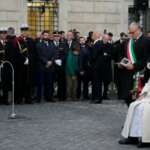A Closer Look at Italy
Italy Flag

Italy Formation Date
March 17, 1861
Italy Capital Name
Rome
Italy Neighbours
Exploring Italy
Introduction
Italy is a beautiful country located in Southern Europe, with a population of over 60 million. It is known for its stunning landscapes, rich culture, delicious cuisine, and world-renowned art and architecture. The official name of the country is the Italian Republic, and it is situated on the Italian Peninsula, surrounded by the Mediterranean Sea, the Adriatic Sea, and the Tyrrhenian Sea. Italy is considered a major global power, with a significant influence on global economics, politics, and culture. In this article, we will explore the history, culture, government, and economy of Italy, and provide valuable information for those interested in visiting or learning more about this fascinating country.Etymology of the Country Name
The name 'Italy' comes from the Latin word 'Italia', which means 'calf land' or 'land of cattle'. This name was given by the ancient Romans, as the peninsula was known for its rich pastures and abundance of cattle. Throughout history, the country has been known by various names, including Enotria, Oenotria, and Vitulia. In the 14th century, the name 'Italy' became the official name of the country.Geography
Italy is a relatively small country, covering an area of 301,340 square kilometers. It is divided into 20 regions, each with its own distinct characteristics and cultural traditions. The country is primarily mountainous, with the Apennine Mountains running down the center of the peninsula. The Alps, Europe's highest and most extensive mountain range, are located in the northern part of the country, bordering with France, Switzerland, Austria, and Slovenia. Italy is also home to two active volcanoes, Mount Etna and Stromboli. The country is blessed with a diverse landscape, including stunning coastlines, valleys, and fertile plains.Origin and History
Italy has a rich and ancient history, with evidence of human settlement dating back to the Paleolithic era. The country has played a significant role in Western civilization, with various civilizations leaving their mark on the land. The ancient Romans, Greeks, Etruscans, and other civilizations have all contributed to the development of Italy. During the Middle Ages, the country was divided into multiple kingdoms and city-states, until it was united in the 19th century under the Kingdom of Italy.Government and Politics
Italy is a parliamentary democracy with a constitutional republic system of government. The President of the Italian Republic is the head of state, while the Prime Minister is the head of government. The country is divided into 20 regions, each with its own regional government. Italy's political parties are divided into two main groups, the center-left and the center-right, with several minor parties also playing a role in the country's political landscape.Commerce and Economy
Italy has a diverse economy, with a strong emphasis on industry, agriculture, and tourism. The country is a leader in the manufacturing of high-end luxury goods, such as fashion, furniture, and automobiles. Agriculture is also a significant contributor to the economy, with Italy being the world's largest producer of wine. Tourism is a vital source of income for the country, with millions of visitors coming to see the famous landmarks, cities, and cultural sites.Demographics
Italy has a population of over 60 million, with the majority of the population living in urban areas. The country has a low population growth rate, with a relatively stable birth and mortality rate. The Italian population is predominantly Italian, with small percentages of other ethnicities, including Albanians, Romanians, and North Africans. The median age in Italy is 47.3 years, with a life expectancy of 83 years.Culture
Italian culture has been heavily shaped by its rich history and diverse geographical landscape. The arts, music, festivals, and traditions play a significant role in daily life and are a source of pride for the people of Italy. The country is known for its beautiful architecture, such as the Colosseum, the Leaning Tower of Pisa, and the Duomo in Florence. Italy is also home to some of the world's most famous artists, including Leonardo da Vinci, Michelangelo, and Raphael.Languages
The official language of Italy is Italian, and it is the most widely spoken language in the country. However, there are also many regional dialects spoken, particularly in rural areas. These dialects have been passed down through generations and show the cultural diversity of Italy. Other languages, such as German, French, and Slovene, are also spoken in small pockets of the country, particularly in regions close to the border with other countries.Religion
Italy is predominantly Roman Catholic, with the religion playing a significant role in daily life and cultural traditions. However, there is a growing number of people who do not identify with any religion, and there are also small communities of Protestants, Jews, and Muslims. The influence of Catholicism can be seen in the country's art, architecture, and traditions.Education System
The education system in Italy is highly valued, with primary and secondary education being compulsory for children between the ages of 6 and 16. The country has a high literacy rate of 99.2%, with education being free and accessible to all. Italy has a diverse range of universities, offering a variety of degrees and courses in different fields of study.Healthcare
Italy has a high-quality healthcare system, with universal coverage and access for all citizens. The country is known for its advanced medical technology and research, particularly in the field of biomedicine. The World Health Organization ranks Italy as the second-best healthcare system in the world, behind France.Sports and Recreation
Sports play an important role in Italian culture, with soccer being the most popular sport. The country also excels in other sports, such as cycling, Formula One racing, and tennis. Italy has hosted major international sporting events, including the Olympic Games and the FIFA World Cup. The country's beautiful landscape also offers many opportunities for outdoor activities, such as skiing, hiking, and water sports.Tourism
Italy is one of the most popular tourist destinations in the world, attracting millions of visitors each year. The country offers something for everyone, from its beautiful cities such as Rome, Florence, and Venice, to its stunning coastal areas like the Amalfi Coast and Cinque Terre. Tourists also come to Italy to experience its rich cultural heritage, explore its historical sites, and indulge in its delicious food and wine.Travel Information for Foreign Visitors
For those planning to visit Italy, here is some essential information to keep in mind.Conclusion
In conclusion, Italy is a fascinating country with a rich history, diverse culture, and a booming economy. Its beauty, both natural and man-made, continues to attract millions of tourists each year. The country's government, education system, and healthcare are highly valued, making it an attractive place to live and visit. As a major global power, Italy continues to play a significant role in shaping politics, economics, and culture. With so much to see and do, it's no wonder that Italy remains one of the most popular tourist destinations in the world.Italy Highest Point Name
Mont Blanc
Italy Highest Point Value
4,807 m
Italy Capital Longitude
Rome, Italy is the capital. Its longitude is 12.4963655
Italy Capital Latitude
Rome latitude is 41.9
Italy Official Languages
The official languages of Italy are Italian, German (in South Tyrol), French (in the Aosta Valley), and Slovene (in some parts of theTriveneto).
Italy Ethnic Groups
Italy has a diverse ethnic mix that includes major groups such as Italians, Albanians, Germans, Slovenes, Croatians, French, Greek, Spaniards, Portuguese, Poles and African-Italians. As of 2011, the Italian population was estimated to be about 61 million, or 88 percent of the total population. The largest ethnic group is the Italians, who make up about 82 percent of the total population, followed by Albanians, who make up about 8.3 percent. Germans form a small minority in Italy, representing only 0.2 percent of the population. The remaining percentage of the population is made up of smaller ethnic groups such as the French, Greeks, Spaniards, Portuguese, Poles and African-Italians.
Italy Religions
Religion has long played a significant role in Italian culture. About two-thirds of Italy's population is Roman Catholic, and the Catholic Church remains influential over vital aspects of Italian life. Other branches of Christianity including Eastern Orthodoxy, Protestantism, and Jehovah's Witnesses are also present throughout the country. In addition, a small percentage of people adhere to various non-Christian religions, such as Judaism, Islam, Hinduism, and Buddhism. Freedom of religion is guaranteed by the Italian Constitution, and the government generally respects this right in practice.
Italy Total Area
301,320 km2
Italy Land Area
Italy has a total land area of 301,340 square kilometers (116,347 sq mi).
Italy Water Area
According to the Central Intelligence Agency World Factbook, Italy has a total water area of around 39,200 km2 (15,145 mi2).
Italy Total Population
60,000,000
Italy Currency Name
Euro
Italy Currency Code
EUR
Italy Currency Symbol
€
Italy Time Zones
- Standard Time: UTC+01:00
- Daylight Saving Time: UTC+02:00
The country of Italy has one primary time zone, Central European Time (CET). This is recognised as UTC+1. From the last Sunday in March to the last Sunday in October, clocks are then shifted forward by one hour for Daylight Saving Time (DST). This is also known as Central European Summer Time (CEST) and is recognised as UTC+2. The time shift usually occurs at 1am local time on the last Sunday of March and returns to CET – UTC+1 – at 1am local time on the last Sunday in October.
Italy Calling Code
+39
Italy Internet TLD
www.aveholidays.it
How to Say "Italy" In Different Languages?
- Portuguese
- Itália (pt-BR)
- Danish
- Italien (da-DK)
- French
- Italie (fr-FR)
- German
- Italien (de-DE)
- Greek
- Ιταλία (el-GR)
- Indonesian
- Italia (in-ID)
- Hebrew
- איטליה (he-IL)
- Italian
- Italia (it-IT)
- Japanese
- イタリア (ja-JP)
- Korean
- 이탈리아 (ko-KR)
- Spanish
- Italia (es-MX)
- Spanish
- Italia (es-PE)
- Filipino
- Italya (tl-PH)
- Polish
- Włochy (pl-PL)
- Romanian
- Italia (ro-RO)
- Spanish
- Italia (es-ES)
- Thai
- อิตาลี (th-TH)
- Turkish
- İtalya (tr-TR)
- English
- Italy (en-US)
- Vietnamese
- Ý (vi-VN)
Italy Popular Holidays
- Epiphany celebration
- 6 January
- Feast of the Epiphany
- 6 January
- Feast of the Epiphany of the Lord
- 6 January
- Feast of the Conversion of St. Paul the Apostle
- 25 January
- Feast of the Chair of St. Peter the Apostle
- 22 February
- Carnival Tuesday
- 25 February
- Feast of St. Joseph
- 19 March
- Feast of San Giuseppe
- 19 March
- Feast of St. Joseph
- 19 March
- Feast of San Giuseppe
- 19 March
- Feast of the Annunciation of the Lord
- 25 March
- Feast of the Annunciation
- 25 March
- Feast of the Annunciation of the Blessed Virgin Mary
- 25 March
- Feast of San Francesco da Paola
- 2 April
- Feast of San Francesco da Paola
- 2 April
- Good Friday
- 2 April
- Easter
- 4 April
- Easter Monday
- 5 April
- Liberation Day
- 25 April
- Feast of Our Lady of Good Counsel
- 25 April
- International Workers’ Day
- 1 May
- Feast of Sts. Philip and James
- 1 May
- Labour Day
- 1 May
- Feast of the Visitation of the Blessed Virgin Mary
- 31 May
- Feast of the Visitation of the Blessed Virgin Mary
- 31 May
- Republic Day
- 2 June
- Festa della Repubblica (Republic Day)
- 2 June
- Corpus Christi
- 3 June
- Feast of the Sacred Heart
- 3 June
- Feast of St. Anthony of Padua
- 13 June
- Feast of St. Anthony of Padua
- 13 June
- Feast of St. John the Baptist
- 24 June
- Feast of St. John the Baptist
- 24 June
- Feast of Saints Peter and Paul
- 29 June
- Feast of Saints Peter and Paul
- 29 June
- Feast of St. Peter and St. Paul
- 29 June
- Feast of St. Dominic
- 4 August
- Feast of St. Dominic
- 4 August
- Feast of San Lorenzo
- 10 August
- Feast of San Lorenzo
- 10 August
- Assumption Day (Assumption of the Blessed Virgin Mary)
- 15 August
- August Bank Holiday
- 15 August
- Feast of Our Lady of the Assumption
- 15 August
- Feast of the Nativity of the Blessed Virgin Mary
- 8 September
- Feast of the Adoration of the Cross
- 14 September
- Feast of the Exaltation of the Holy Cross
- 14 September
- Feast of San Michele
- 29 September
- Feast of St. Michael the Archangel
- 29 September
- Feast of St. Francis of Assisi
- 4 October
- Feast of the Holy Rosary of Pompeii
- 7 October
- Feast of the Holy Rosary of Pompeii
- 7 October
- Feast of St. Edward the Confessor
- 13 October
- All Saints’ Day
- 1 November
- Feast of All Saints
- 1 November
- Feast of All Souls
- 2 November
- Day of the Dead
- 2 November
- Feast of Santa Maria della Salute
- 4 November
- Feast of Santa Maria della Salute
- 4 November
- Feast of Christ the King
- 22 November
- Feast of St. Andrew
- 30 November
- Feast of St. Andrew
- 30 November
- Feast of the Immaculate Conception
- 8 December
- Feast of the Immaculate Conception
- 8 December
- Feast of the Immaculate Conception of the Blessed Virgin Mary
- 8 December
- Christmas Eve
- 24 December
- Christmas
- 25 December
- Feast of St. Stephen
- 26 December
- Feast of St. Stephen
- 26 December




















